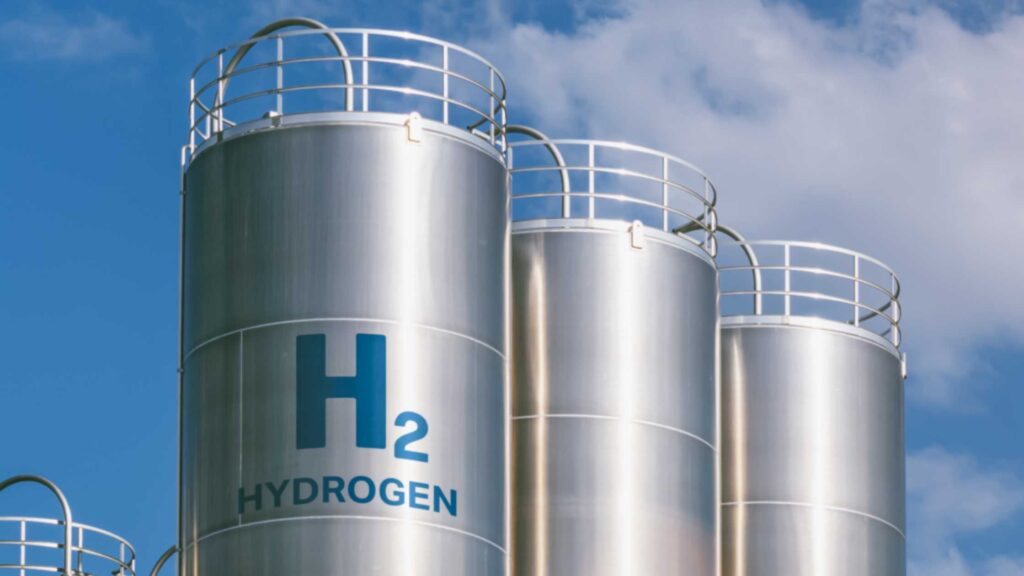If you’ve been keeping an eye on energy trends lately, you’ve probably heard about green hydrogen. It’s being hailed as the ultimate clean energy solution and the key to a sustainable future. But what exactly is green hydrogen, and why is it generating so much excitement? Let’s take a deep dive into this fascinating topic, exploring its potential to revolutionize the energy sector, reduce carbon emissions, and transform how we power our world.
What Is Green Hydrogen?
We must first define hydrogen in order to comprehend green hydrogen. Since it makes up roughly 75% of all matter, hydrogen is the most prevalent element in the universe. Hydrogen is not present in its pure form on Earth; instead, it is bonded to organic compounds and water (H2O). When separated, it transforms into a very adaptable energy carrier.
This is where “colour coding” comes in, with names like gray hydrogen, blue hydrogen, and green hydrogen being used to indicate the various ways that hydrogen can be created. Today, we’re talking about green hydrogen, which is made by electrolyzing water using sustainable energy sources like solar or wind. Green hydrogen is a genuinely clean and sustainable energy source since it produces hydrogen and oxygen from water without releasing any greenhouse gases.

Why Is Green Hydrogen Important?
The pressing need to address climate change is the driving force behind the demand for green hydrogen. Green hydrogen is a viable approach to decarbonize hard-to-electrify industries as nations work to reach carbon reduction targets and move away from fossil fuels. Let’s examine the reasons why green hydrogen is so crucial in the current energy environment:
1. Renewably abundant: Hydrogen provides an almost infinite energy source since it can be made from water and generated using renewable energy. Green hydrogen is clean and sustainable, in contrast to fossil fuels, which are limited and release carbon emissions.
2. Adaptable Energy Transporter: In addition to being a fuel, hydrogen can store energy and generate power. Because of its adaptability, it may be used in a variety of sectors, including industry, transportation, and even homes.
3. Decarbonizing Difficult Sectors: Although solar panels and wind turbines can generate renewable electricity, some businesses, such as the steel industry, long-haul shipping, and aviation, need help electrifying. Green hydrogen can close this gap by offering a carbon-free energy source for industries that would otherwise be challenging to decarbonize.
4. Solution for Energy Storage: Intermittency—the sun doesn’t always shine, and the wind doesn’t always blow—is one of the main problems with renewable energy. Here, hydrogen provides a solution; it may assist in balancing the grid by storing excess renewable energy during periods of high production and releasing it during periods of increased demand.
How Is Green Hydrogen Produced?
Electrolysis is essential to the creation of green hydrogen. In this technique, water is divided into hydrogen and oxygen using an electric current. The hydrogen generated by an electrolyzer powered by renewable energy sources, such as solar or wind, is referred to as “green.”
Three primary categories of electrolysis technology exist:
- Alkaline electrolysis is the most traditional and well-established technique. It splits water molecules and conducts electricity using a liquid alkaline solution. Alkaline electrolysis is a low-cost method of producing hydrogen that has been used for many years.
- Proton Exchange Membrane (PEM) Electrolysis: PEM electrolysis conducts energy and extracts hydrogen from water using a solid polymer electrolyte. Because rare metals like platinum are required, it is more costly than alkaline electrolysis despite being more efficient.
- Solid Oxide Electrolysis: This more recent technique splits water molecules by conducting electricity through a solid ceramic substance. Although it works more efficiently at higher temperatures, there are issues with cost and durability.
The electrolyzer—the central component of the hydrogen manufacturing process—needs a consistent flow of renewable electricity to function. By attaching an electrolyzer to solar farms or wind turbines, we can guarantee that the entire production process stays carbon-free.
Applications of Green Hydrogen
Green hydrogen has practically endless potential applications in a variety of industries. Let’s examine some of the ways that green hydrogen is being utilized to power the future in more detail:
Transportation
Green hydrogen has the potential to completely transform the transportation sector, particularly in areas where battery-electric vehicles (BEVs) encounter difficulties. Despite their growing popularity, electric automobiles have limitations in terms of their weight-bearing capabilities, charging time, and range. Vehicles that use hydrogen fuel cells can be helpful in this situation.
The only consequence of the chemical reaction between hydrogen and oxygen that generates power in hydrogen fuel cells is water vapour. Fuel cell electric vehicles (FCEVs) are perfect for heavy-duty transportation like trucks, buses, and even trains since they have a number of advantages over BEVs, including greater ranges and quicker refilling periods.
For example, numerous European nations are creating hydrogen-powered trains for regional routes, and South Korea and Japan are making significant investments in hydrogen-powered trucks and buses.
Industry
Decarbonizing industrial processes is a significant obstacle to reaching global climate targets. Due to their high temperatures and energy requirements, industries like steel, cement, and chemicals are infamously carbon-intensive and challenging to electrify.
Green hydrogen provides an option by serving as a reducing agent and a fuel in many industrial processes. For instance, hydrogen can significantly lower carbon emissions in the blast furnace used to produce steel by replacing coal. Businesses like SSAB in Sweden are already using green hydrogen to create “fossil-free steel,” establishing a model for sustainable industrial manufacture in the future.
Power Generation and Energy Storage
Green hydrogen can also be quite important in electricity generation. It offers a sustainable energy alternative for peak power demands by generating electricity in gas turbines without releasing carbon dioxide.
Furthermore, hydrogen is a practical way to deal with the intermittent nature of renewable energy sources due to its high energy storage capacity. Excess wind or solar power can be turned into hydrogen to store energy for extended periods of time and transform it back into electricity when required. This helps stabilize the grid and guarantee a steady supply of energy.
Heating
Green hydrogen has the potential to be used for both commercial and household heating. To cut carbon emissions, hydrogen can be combined with or used in place of natural gas, which is frequently used for heating. Actually, the use of hydrogen in home heating systems is already being investigated in experimental programs in the UK.
The long-term advantages of lowering carbon emissions from heating are significant, particularly in colder climates where heating accounts for a sizable share of energy usage, even when modifying current infrastructure brings specific difficulties.
Challenges Facing Green Hydrogen
Despite the obvious potential of green hydrogen, a number of obstacles must be overcome before widespread adoption may occur:
- Cost: At the moment, producing green hydrogen is more costly than producing other types of hydrogen. Compared to gray or blue hydrogen, green hydrogen is less economically feasible due to the expense of electrolyzers and the requirement for a steady supply of renewable energy. However, it is anticipated that prices will decrease in the upcoming years due to economies of scale and technical developments.
- Infrastructure: The infrastructure needed to produce, store, and distribute hydrogen is still in its infancy. Hydrogen requires new infrastructure for storage and delivery, which can be expensive to construct, in contrast to fossil fuels, which have existing supply chains.
- Efficiency Loss: Direct use of renewable energy is more efficient than converting it into hydrogen and then using it to generate electricity. Green hydrogen may only sometimes be the best option due to this efficiency loss, especially in situations when direct electrification is feasible.
- Policy and Regulation: Green hydrogen needs supportive policies and regulations in order to become competitive. Governments must fund infrastructure and research, offer production incentives, and enact laws that prioritize clean hydrogen over fossil fuels.
Green Hydrogen Around the World
Globally, nations are realizing the potential of green hydrogen and making significant investments to further its development. Let’s examine a few of the industry leaders in green hydrogen:
Europe
As part of its Green Deal, the European Union has set high goals for green hydrogen, with the goal of making the region carbon neutral by 2050. Leading the way are nations like Germany, Spain, and the Netherlands, which are spending billions on infrastructure and initiatives related to hydrogen. To promote widespread adoption, the “Hydrogen Strategy for a Climate-Neutral Europe” calls for the installation of 40 GW of electrolyzers by 2030.
Australia
Australia has the potential to become a major supplier of green hydrogen due to its strong winds and abundance of sunshine. With intentions to export hydrogen to nations like South Korea and Japan, which lack the renewable energy resources required for domestic hydrogen production, the nation is investing in several projects to create hydrogen using solar and wind power.
South Korea and Japan
One of the first nations to include hydrogen in its energy policy was Japan, which intends to create a “hydrogen society.” It seeks to lessen its need for fossil fuels by using green hydrogen for industry, transportation, and power generation. Similar to this, South Korea has unveiled a plan to create a hydrogen economy, emphasizing fuel cells and automobiles that run on hydrogen.
The Road Ahead: How Close Are We?
Although the idea of green hydrogen is not new, its application is becoming increasingly popular as global commitment to sustainability and carbon reduction increases. The green hydrogen economy is now closer than ever to becoming a reality because of rising investments, declining costs for renewable energy, and encouraging policies.
However, much more work needs to be done before green hydrogen is widely used as an energy source. Governments, businesses, and research institutes must work together to overcome the present technological and economic obstacles. Green hydrogen will probably play a bigger part in our energy mix as prices come down and infrastructure improves.
Conclusion: Fueling a Greener Future
Green hydrogen has the potential to revolutionize the energy industry by providing a clean, renewable, and adaptable answer to some of the most pressing problems of our time. Green hydrogen is opening the door to a sustainable future by allowing us to store renewable energy, decarbonize challenging sectors, and increase our energy independence.
Even though there are still challenges to be solved, green hydrogen is clearly gaining traction. Recognizing that hydrogen might be a vital element of a low-carbon economy, governments and businesses around the world are investing in infrastructure and research. Green hydrogen has the potential to power our future, one that is abundant, sustainable, and accessible in terms of clean energy.


